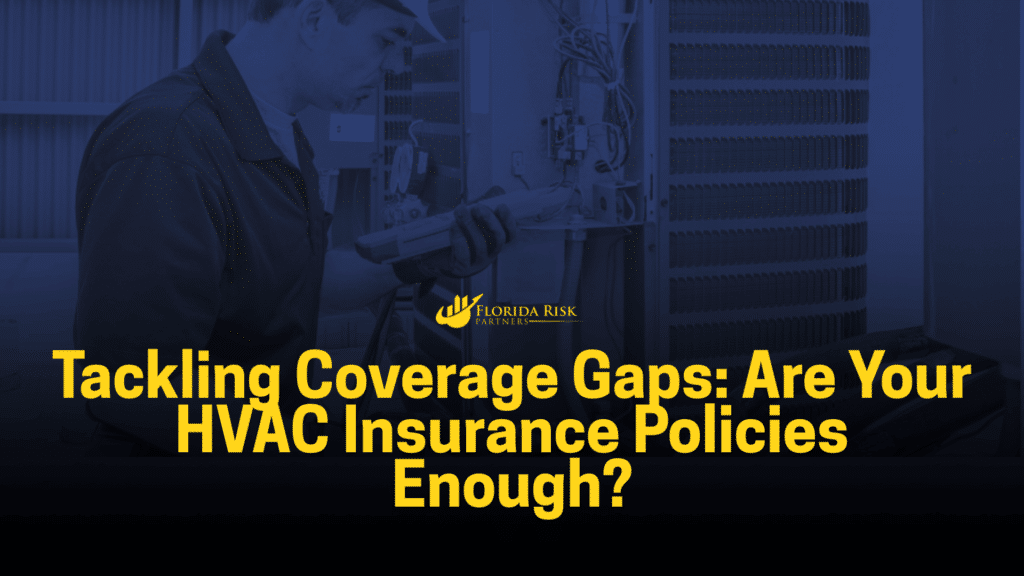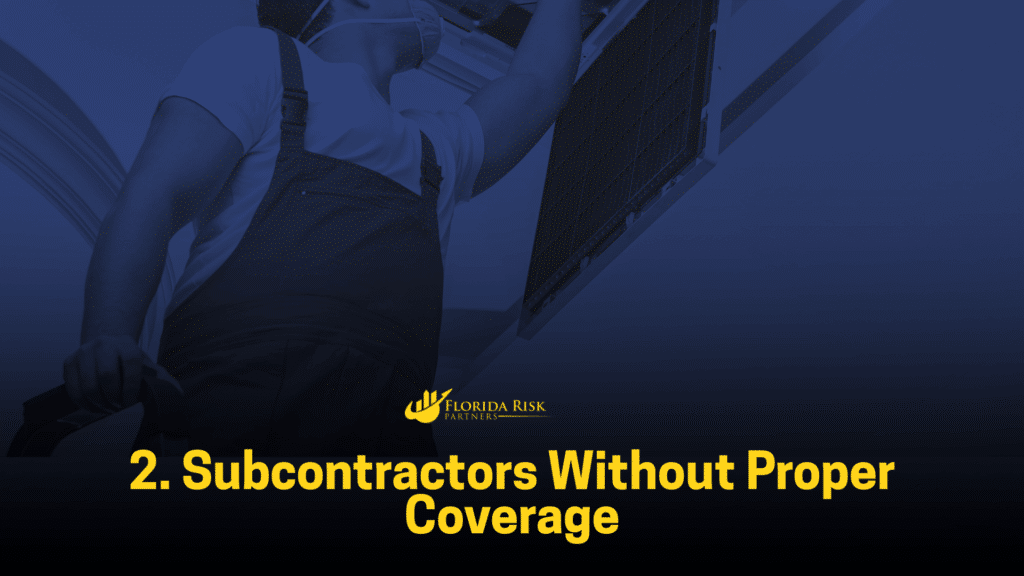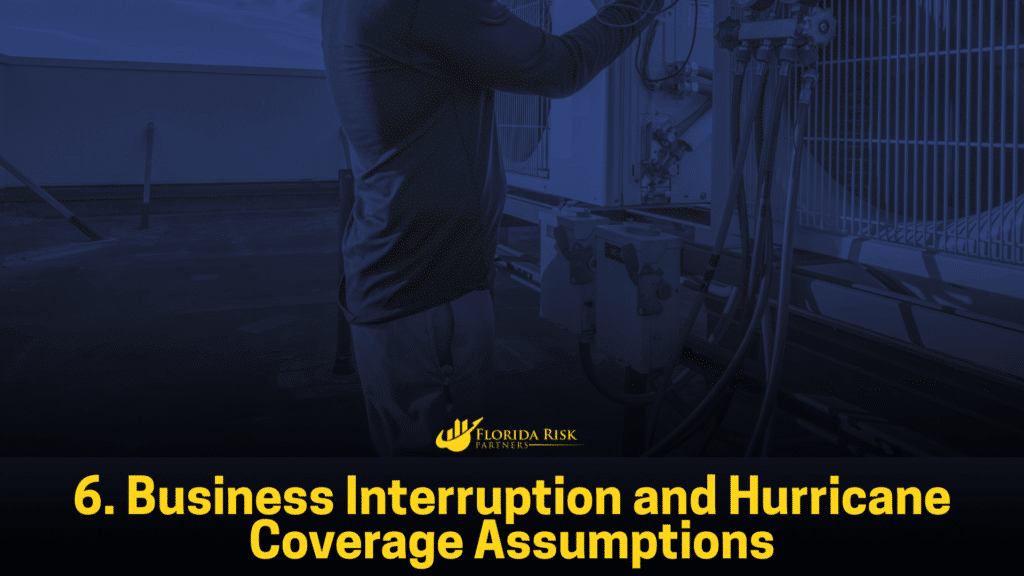-
Main Office: 1434 E. Bloomingdale Ave Valrico, FL 33596-6110
-
Phone: (888) 601-6660
-
Email: info@floridariskpartners.com

In this post, we’ll break down the most common coverage gaps we see in HVAC insurance programs and show you how to spot them before they cost you time, money, and reputation. Consider this your HVAC business’s mid-year insurance checkup.
What Is a Coverage Gap?
A coverage gap is any situation where a specific risk or exposure exists—but your current insurance program doesn’t protect you from it.
In the HVAC business, that could mean:
- Not having coverage for tools stolen from a van
- Assuming subcontractors have their own workers’ comp (but they don’t)
- Failing to insure a newly purchased service truck
- Not including completed operations liability after an install
- Missing pollution coverage for refrigerant-related claims
Insurance gaps don’t always result from negligence. Sometimes, your policy simply doesn’t align with your business model. Or your company grew and evolved, but your insurance program didn’t grow with it.
Common HVAC Coverage Gaps That Can Derail Your Business
Here are the top coverage gaps Florida HVAC contractors should watch for:
1. Tools and Equipment Not Covered in Transit
Many contractors assume that their tools are covered under the auto policy if they sit in the back of a van. Not true.
Reality: Most commercial auto policies exclude tools, equipment, and materials unless added through a special endorsement. You’ll need inland marine insurance or a contractor’s equipment floater to protect your gear on the move or at a jobsite.
To fix it, inventory your tools, list their values, and confirm that you schedule them or protect them under a blanket inland marine policy.
2. Subcontractors Without Proper Coverage
You hire a subcontractor for ductwork installation. They show you a certificate of insurance, but it’s expired or doesn’t list you as an additional insured. Then, someone hurts themselves, and you get pulled into a lawsuit.

If your subcontractors lack valid general liability and workers’ compensation, you could take responsibility for their actions or injuries.
How to fix it:
- Require up-to-date Certificates of Insurance (COIs) from every subcontractor.
- Ensure they name your company as additional insured.
- Build these requirements into your subcontractor agreements.
3. Hired and Non-Owned Auto Exposure
Your office manager uses their personal car to run errands for the business. Or a technician borrows a rental truck to transport a rooftop unit. If they get into an accident—your company can be sued.
If a lawsuit names your business in relation to a non-owned vehicle and you don’t have Hired and Non-Owned Auto (HNOA) coverage, you could pay out of pocket.
How to fix it: Add an HNOA endorsement to your commercial auto policy to cover liability from personal and rental vehicles used for business purposes.
4. Pollution Liability Gaps
Florida HVAC companies work with refrigerants, chemicals, and ventilation systems—any of which can trigger pollution-related claims. Think mold from improper ductwork, refrigerant leaks, or poor indoor air quality.
Reality: Standard general liability policies often exclude pollution, mold, or environmental damage.
How to fix it: Add Contractor’s Pollution Liability (CPL) coverage or a pollution endorsement that fits your scope of work.
5. Completed Operations Not Fully Covered
Let’s say you install a system today, and six months later it causes water damage due to improper installation. Will your insurance cover the damage?
Reality: If your general liability policy is not structured correctly—or you’ve failed to renew your products and completed operations coverage—you may be left unprotected.
How to fix it: Ensure your general liability includes full completed operations coverage with appropriate limits for your size and scope of work.
6. Business Interruption and Hurricane Coverage Assumptions
Florida is ground zero for hurricanes, tropical storms, and flooding. Yet many HVAC companies assume their commercial property insurance will cover storm damage and business downtime.

Reality: Many standard policies exclude flood or windstorm unless specifically added. And business interruption coverage must be structured to include storm-related shutdowns.
How to fix it: Review your commercial property and business income policies with an agent familiar with Florida exposures. Add flood insurance or windstorm endorsements if needed.
Real-Life Claim Scenarios: Coverage Gaps That Hurt
Let’s explore a few real-life examples where Florida HVAC contractors learned the hard way:
Scenario 1: Stolen Tools Not Covered
A technician left a van unlocked for 10 minutes while grabbing lunch. $12,000 in tools were stolen. The company’s auto policy didn’t cover the theft, and there was no inland marine policy in place. Full replacement costs were paid out-of-pocket.
Scenario 2: Subcontractor Injury Lawsuit
A subcontractor fell from a ladder on a residential job. They had no workers’ comp coverage—and filed a claim against the general HVAC contractor. Without proper COI management, the company’s general liability policy was forced to respond, leading to a $78,000 loss.
Scenario 3: Uninsured Personal Vehicle Crash
An employee used their own truck to deliver a condenser unit to a jobsite and caused a three-car accident. Because the business didn’t carry HNOA coverage, it had to defend itself in court and cover a large settlement from its operating reserves.
How to Identify Coverage Gaps in Your HVAC Insurance Program
Here’s a simple checklist to get started:
Do you have a complete inventory of tools, vehicles, and equipment—and are they all insured?
Are you requiring and verifying COIs from every subcontractor?
Are you covered for pollution, mold, or refrigerant leaks?
Do you have HNOA coverage for personal and rented vehicles used for work?
Is your business interruption policy designed for hurricane season?
Have you reviewed your policy limits and endorsements in the last 12 months?
If you answered “no” or “I’m not sure” to any of the above, it’s time for a coverage gap analysis.
Partner with an Agent Who Specializes in HVAC Risk
A generic insurance program won’t cut it for HVAC contractors operating in Florida. You need a partner who:
- Knows construction-class risk inside and out
- Understands how your operations, tools, and subcontractor use impact coverage
- Keeps up with ever-changing legal and environmental exposures
Your insurance shouldn’t just be a file in a drawer. It should be a dynamic, protective shield that evolves as your business grows.
Final Thoughts: Don’t Wait for a Denied Claim to Find the Gaps
Florida HVAC contractors work in complex, mobile, high-risk environments, which means you must build your insurance program with precision. Coverage gaps may seem small, but when claims happen, they can cost tens of thousands—or more.
Investing the time now to review and upgrade your policy could be the difference between business as usual and business shut down.
Call Us Or
Schedule an Appointment
Select an agent below to view our online calendars and select a day and time that works best for you or call us directly at 888-601-6660. When you use our online calendars, you will receive an email with more information.



